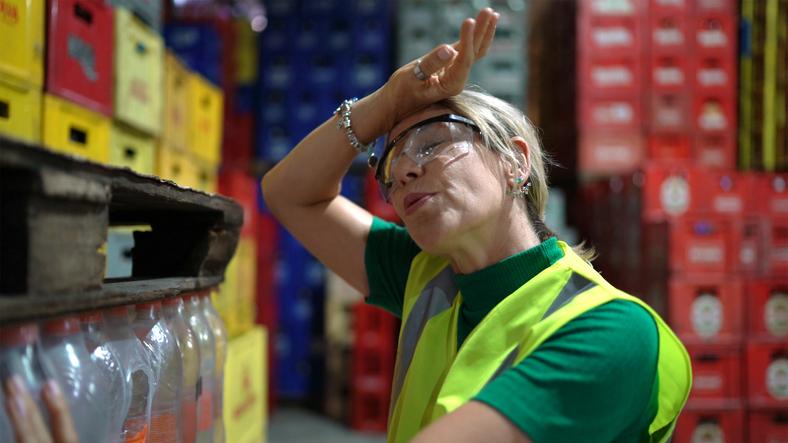Contributing Writer
- FMA
- The Fabricator
- FABTECH
- Canadian Metalworking
Categories
- Additive Manufacturing
- Aluminum Welding
- Arc Welding
- Assembly and Joining
- Automation and Robotics
- Bending and Forming
- Consumables
- Cutting and Weld Prep
- Electric Vehicles
- En Español
- Finishing
- Hydroforming
- Laser Cutting
- Laser Welding
- Machining
- Manufacturing Software
- Materials Handling
- Metals/Materials
- Oxyfuel Cutting
- Plasma Cutting
- Power Tools
- Punching and Other Holemaking
- Roll Forming
- Safety
- Sawing
- Shearing
- Shop Management
- Testing and Measuring
- Tube and Pipe Fabrication
- Tube and Pipe Production
- Waterjet Cutting
Industry Directory
Webcasts
Podcasts
FAB 40
Advertise
Subscribe
Account Login
Search
Debate about federal heat standards for manufacturing companies begin
After several months of inaction, OSHA seeks input from manufacturers about indoor heat
- By Stephen Barlas
- July 10, 2023

The Occupational Safety and Health Administration has begun the process of collecting comments about a possible indoor heat standard for manufacturers. Meanwhile, many manufacturing groups don't see the need for such regulation. FG Trade/E+
The Biden administration is picking up its regulatory efforts to force companies to reduce temperatures in indoor work environments, such as manufacturing facilities.
The Occupational Safety and Health Administration (OSHA) has scheduled upcoming discussions about how these new workplace heat standards could affect small businesses. As part of its process, the OSHA is holding Small Business Advocacy Review Panel meetings this summer.
In October 2021, the agency started—via an advanced notice of proposed rulemaking (ANPR)—to develop a potential standard for workplaces to prevent heat illness and injury in outdoor and indoor environments in general industry and in the construction, maritime, and agriculture industries. But the agency had not moved forward subsequently.
It is under some political pressure to do so from members of Congress and public interest groups. OSHA has received three petitions to implement a heat standard from Public Citizen and supporting organizations, in 2011, 2018, and 2021. In August 2021, OSHA received a request for rulemaking from members of both the Senate and the House of Representatives. Both chambers of Congress also had pending legislation in the 2021-2022 legislative session that would order OSHA to develop and implement a federal heat standard. But there has been no progress on Capitol Hill, ostensibly forcing the OSHA’s hand.
When it issued its ANPR in 2021, OSHA cited the four states that had enacted hazardous heat standards requiring employers in various industries and workplace settings to provide protections and abatement measures to reduce the risk of heat-related illness for their employees: California, Minnesota, Oregon, and Washington. The latter is the only state to have an indoor standard, which triggers protection and action by the employer when indoor temperatures hit somewhere between 77 degrees F to 86 degrees F based on workload.
Other states have proposed heat standards. Groups including the American Industrial Hygiene Association assailed the draft standard proposed in October 2022 by the Maryland Occupational Safety and Health agency because they felt it was too weak.
Industry groups opposed an OSHA standard when the agency issued the ANPR in 2021. Dan Walker, managing director of the Industrial Fasteners Institute, wrote: “In summary, IFI does not believe an indoor heat standard is necessary because employers are already implementing appropriate mitigation measures when appropriate, and the fastener industry does not have a record of heat-related injuries. These mitigation measures and current OSHA standards and guidance regarding heat prevention strategies are adequate.”
Miles Free, director, industry research and technology, at the Precision Machined Products Association, explained that in a December 2021 survey of association members, respondents indicated they do not have heat-related challenges in their shops or have already taken steps to mitigate potential risks in the facility.
“Taking all survey respondents together, employees worked 29.9 million hours over the past five years with only a single instance at a single shop reporting a heat-related incident,” Free explained. “When it comes to manufacturing, this proposed rule is simply a solution in search of a problem that does not exist in the precision machining industry.”
OSHA established a national emphasis program on heat inspections targeting high-hazard industries in April 2022. Among the North American Industry Classification System industry sectors identified for inspections were Other Fabricated Metal Product Manufacturing, Motor Vehicle Parts Manufacturing, Aerospace Product, and Parts Manufacturing to name just a few.
subscribe now

The Fabricator is North America's leading magazine for the metal forming and fabricating industry. The magazine delivers the news, technical articles, and case histories that enable fabricators to do their jobs more efficiently. The Fabricator has served the industry since 1970.
start your free subscriptionAbout the Author

Stephen Barlas
- Stay connected from anywhere

Easily access valuable industry resources now with full access to the digital edition of The Fabricator.

Easily access valuable industry resources now with full access to the digital edition of The Welder.

Easily access valuable industry resources now with full access to the digital edition of The Tube and Pipe Journal.
- Podcasting
- Podcast:
- The Fabricator Podcast
- Published:
- 04/16/2024
- Running Time:
- 63:29
In this episode of The Fabricator Podcast, Caleb Chamberlain, co-founder and CEO of OSH Cut, discusses his company’s...
- Trending Articles
Tips for creating sheet metal tubes with perforations

Supporting the metal fabricating industry through FMA

JM Steel triples capacity for solar energy projects at Pennsylvania facility

Fabricating favorite childhood memories

Omco Solar opens second Alabama manufacturing facility

- Industry Events
16th Annual Safety Conference
- April 30 - May 1, 2024
- Elgin,
Pipe and Tube Conference
- May 21 - 22, 2024
- Omaha, NE
World-Class Roll Forming Workshop
- June 5 - 6, 2024
- Louisville, KY
Advanced Laser Application Workshop
- June 25 - 27, 2024
- Novi, MI


























